Instead of screaming into the void of Twitter, I bring you a weekly highlight reel of what it’s like going places in Greater Hartford when one is gloriously car-free. These posts are on a slight time delay because nobody needs to know exactly where I am when I am there.
This was not the first time I’d biked to the Wethersfield/Newington/Hartford line, but it was the first time I let Google Maps tell me which route to take, and that was dumb. I knew it before I even left the house.
I understand why it sent me on the Frog Hollow Expressway, or what outsiders refer to as Fairfield Avenue via Park Terrace, the stub of Summit Street, and then Zion Street. It’s probably not Google’s fault for not knowing any better. It picked streets where there is paint indicating a bike lane or sh(itty)arrows, but say it with me: paint alone is not protection.
My bicycle is not a lightweight racing bike. She’s thick. Even more now that she has multiple battery packs and was carrying a camera, lock, and full water bottle. Not a plastic water bottle. Why would I opt for that when I can choose something even heavier?
First minute of ride: correct direction down half of a one-way street, expertly dodging pot holes because I know where each one is. Able to make a left turn onto a stupidly fast street because there was a creepy lull in traffic. This is going to be great! Smooth sailing! Nobody has honked at me in the 2.5 blocks I’ve traveled.
And then?
And then a lane disappeared by Pope Park, where there is no sidewalk, so I had my first “rear end a parked car or take the lane and piss everyone off” moment. Looking at Summit Street, I realize I need to get on the sidewalk because it’s too much hill combined with too much road chaos. That’s fine. I can get off and push for one minute. It’s not like I’m some dude who has something to prove.
Except toward the top, some clueless person is doing this thing that I can’t understand. One person is standing outside a car, another person is in the car, just chilling, with door blocking most of the sidewalk. Person in vehicle is resting foot on the opened door. The person on the sidewalk sees me approaching. I am visible, or rather, if nothing else, my bike is visible. I assume they’ll close door and let me through. Ha, ha. Nope. There’s also a row of recycling or trash cans on other side, making the space tighter. So, I push my bike through, scratching my hand on the bins while dragging the bike against the car. They just stared. This was all in the first three minutes of my trip.
Next up: turning onto Zion Street, where there are faux bike lanes. There is paint, but nothing to prevent people from driving vehicles into the space. I’m about one minute on this road, thinking that perhaps those sidewalk blocker dudes aren’t going to come after me, when I get punish passed by a genius in a shitbox who had to wait five seconds for me to roll by before he could turn from a side street onto Zion. And by punish passed, I mean he swerved right into the lane next to me and I had to ride into the parking area to avoid him. Then, I have some dodging to do of construction equipment beached in the bike lane, along with an SUV that someone parked at an angle in the lane because they’re too incompetent to parallel park and someone’s bodega run is always an emergency.
I still had a ways to go before reaching my destination: Cedar Hill Cemetery. Why the cemetery? It’s there. And because that way, if some asshole splattered me on the road, my friends could all say shit like “Well, she did say she was trying to visit the graveyard.”
Here’s the other problem with the bogus Zion Street “bike lane”: it ends when you need it most — going up a hill by the intersection of New Britain Avenue and Fairfield Avenue. You know, the one where people die because instead of reducing travel lanes, the City would rather put out a large sign asking people to slow down.
I sweat my ass off to make it across the way, and then ride on the joke sidewalk that’s broken and just stops in the park, because I guess nobody thought having sidewalks along the edges of all city parks would be useful. I off-roaded for a bit, hoping to not suffer the consequences as Hyland Park along Fairfield Avenue is basically one long path of broken beer bottles.
Not sure when the exact moment was, but I decided to get back on the street where there are sh(itty)arrows (“full of sound and fury, signifying nothing”) and fast cars. Fairfield Avenue at least has a little more space for avoiding the parked cars. There are driveways. Why is on-street parking even allowed here? Why is it allowed anywhere?
When this got old, I moved onto the sidewalk. As we know, sidewalks don’t protect either (see: dumb shits having car parties with open doors) and this means needing to watch every single driveway and then do super awkward street crossing.
So, I make it to the cemetery, of my own accord.
You may think this would mean stress-free cycling. You’d be wrong.
There is a special ring of hell for people who decide to go bombing around in graveyards. They’re probably related to the folks who must get their Doritos and Red Bull, stat. What’s the emergency? Do you think Great Great Aunt Doris can’t wait another ten seconds for you to arrive with her annual Mums? Calm down. She’ll still be there even if it takes you another hour — trust me.
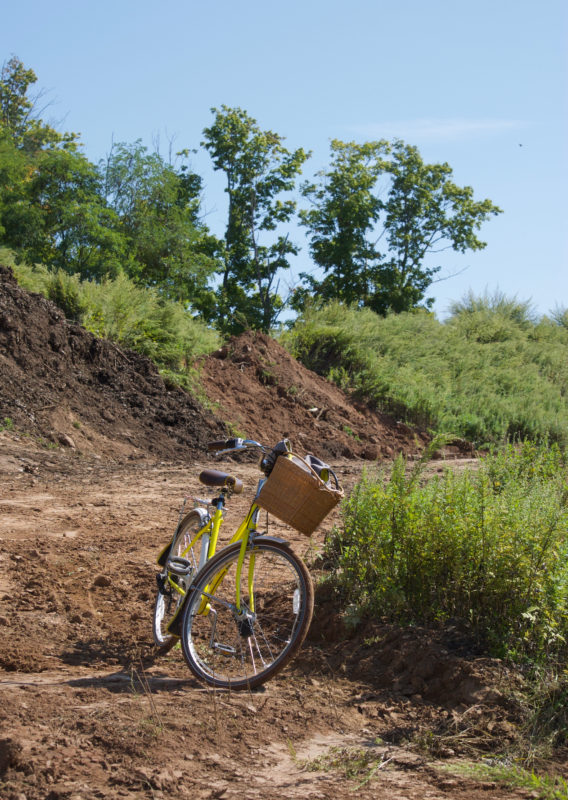
It got much better when I put myself in areas where people were not allowed to wear their cars.
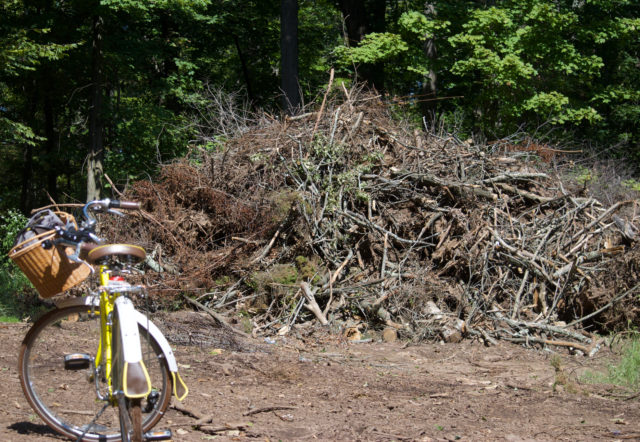
Deer, hawks, vultures, dragonflies, lots of mud. That’s what I came for.
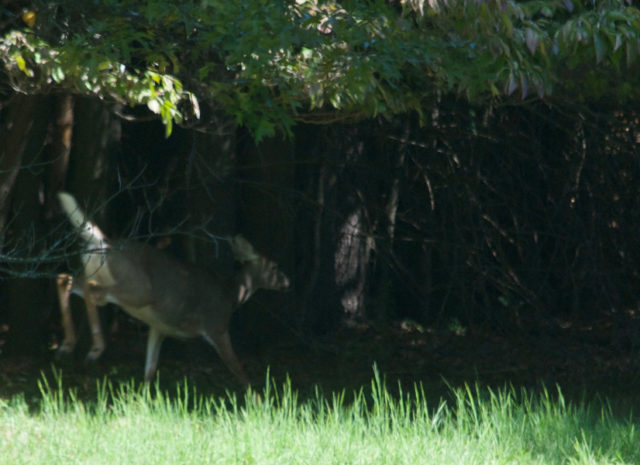
When it was time to return home — as dictated by my growling stomach and desire to not remain here forever — I did have to think through the route in advance, so that I did not turn without thinking and wind up back on Zion Street.
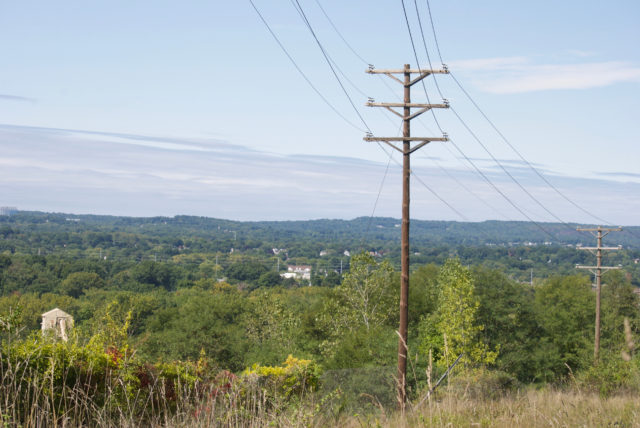
Because being less aggravated is more important than worrying if I lose cred, I did sidewalk riding on Fairfield until just before the New Britain Avenue intersection, then got back in the street to take Summit along the Trinity College campus. This turned out to be a good decision because Summit Street is now significantly less of a hellscape. There are no bike lanes, but recent changes to the road makes it feel manageable in ways that Zion Street, with “bike lanes,” simply does not.
What changed? There are several speed humps, and at the intersection with College Terrace, a flashing red light has been added at the stop sign.
From there, I rode through Zion Hill Cemetery — no cars to dodge, partly because there are no overly wide roads — and then back on the streets where there were no painted bike lanes or sh(itty)arrows, yet less chaos for whatever reason.
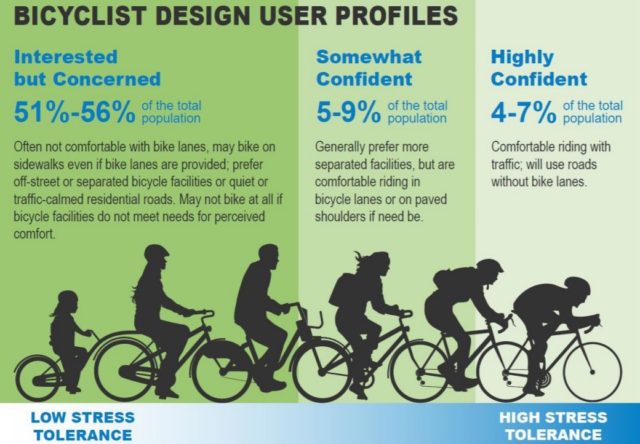
The graphic above (props: US DOT Federal Highway Administration) has been getting some circulation on social media lately, and I think it’s both useful and trash, because we can have a lot of conflicting feelings at once.
I’m stuck on the word “confident.” Also, “comfortable.”
By behavior, I would probably be on the far right part of this infographic.
By emotion, I would be home on the couch.
Confident in what way?
Confident that riding on the road means I’m gonna die and the driver won’t even lose their license after killing me?
Okay then.
I am not comfortable with fake ass bike lanes or with riding in traffic, but depending on where I am, the alternatives, and my mood, I will do those things. And again, because I am not some bike bro obsessed with my cred and looking tough, I will ride on the sidewalk if that’s significantly better than the street.
This infographic would perhaps be more accurate if it measured things like how exasperated a cyclist was with how the roads (that cyclists were responsible for creating) were ripped out from them, and the amount of begging it takes to get slivers of it back. Maybe a “resentful and anxious, but riding on the road anyway” category. How about showing riding behavior without linking it to feelings?
It does illustrate something important though: most cyclists are not willing to cycle on all roads regardless of conditions. This informs, or should inform, design such that it caters to the majority of riders.
For too long, the most vocal cyclists have tended to be those representing a very narrow demographic, and now that others are out there and speaking up, there’s the predictable eye-rolling backlash. And I’m here to make it very uncomfortable for those would-be gatekeepers who make ableist comments.
HARD OUT HERE FOR A BOLLARD
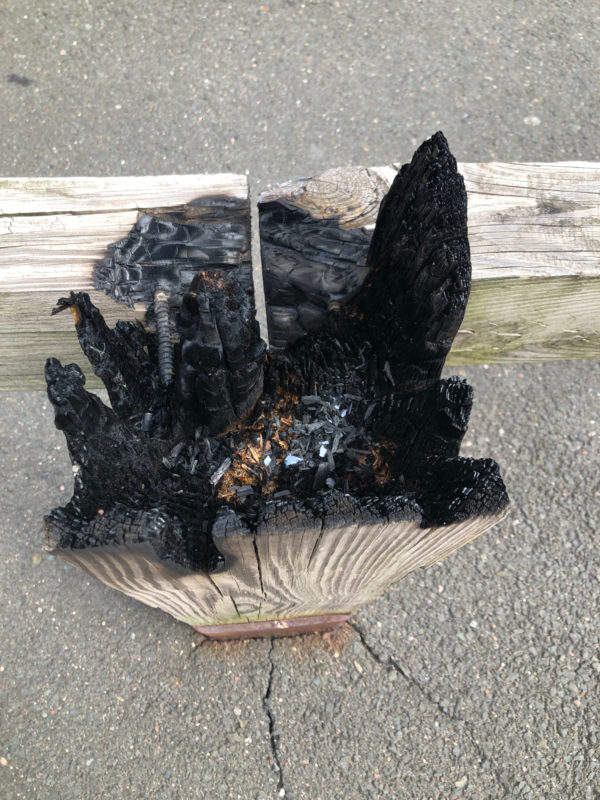
The few bollards in downtown Hartford are not looking so well.
The wooden ones defending a sidewalk against a surface lot appear to have been set on fire. Have they always been like this and I never noticed? Is this new? I’d ask who is lighting bollards on fire, but it’s probably the same person who ignites portapotties.
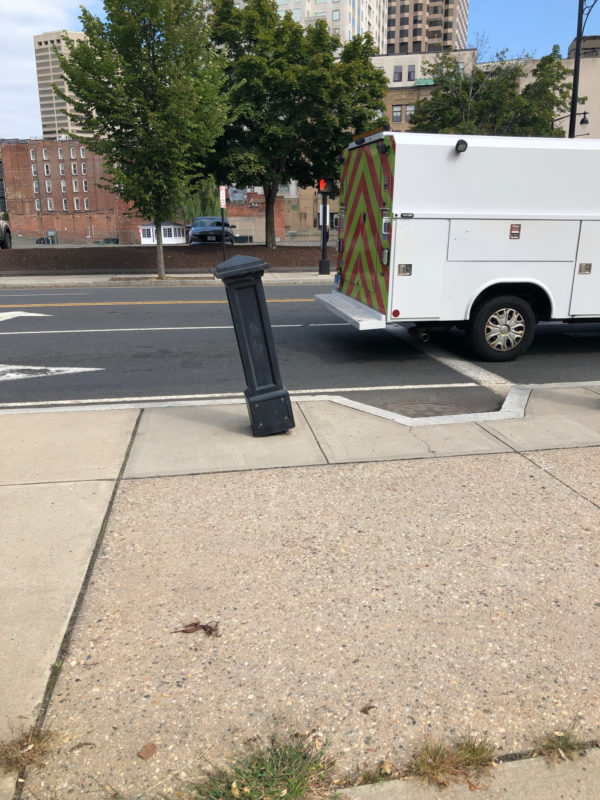
Not surprising in the least, a bollard by Bushnell Park has gotten abused.
When, instead of narrowing streets around a park so that people drive slower, you remove medians. . . don’t be surprised when automobilists ditch their vehicles in the landscaping and beside benches.
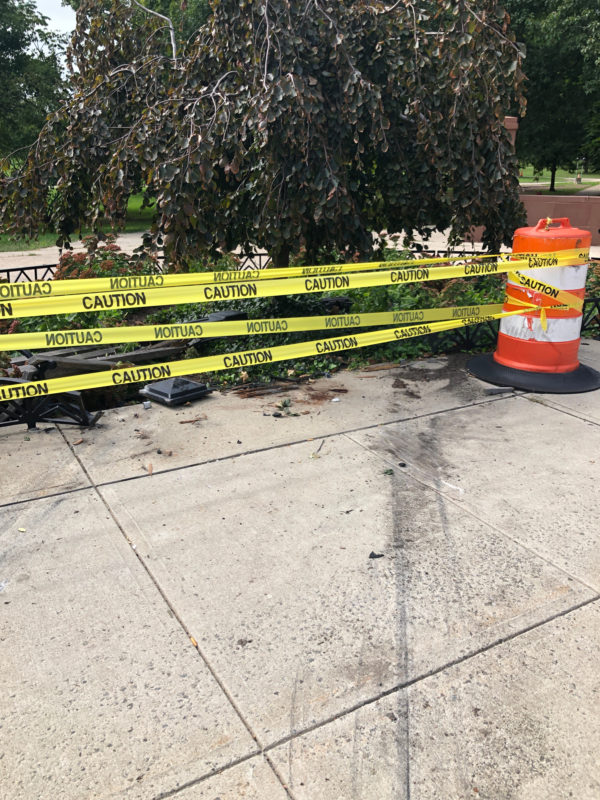
Maybe that’s not exactly what happened, but the marks are there.
At what point are the downtown dwellers and Friends of Bushnell Park going to get involved in dealing with this unpleasantness? Between the speeding around the park and the driving in it, you have to wonder about people’s priorities.
The last two summers have been increasingly obnoxious, with more and more people driving through the park during events. It’s not legal. There’s no reason for it. More than once, I’ve watched as drivers come out of the park, competing with pedestrians entering it during the pedestrian light phase by Union Station. Why does it feel like asking for so much to have one car-free space in a neighborhood, where people of all ages can relax without having to be vigilant about someone driving through who might “confuse” the gas with the brake?
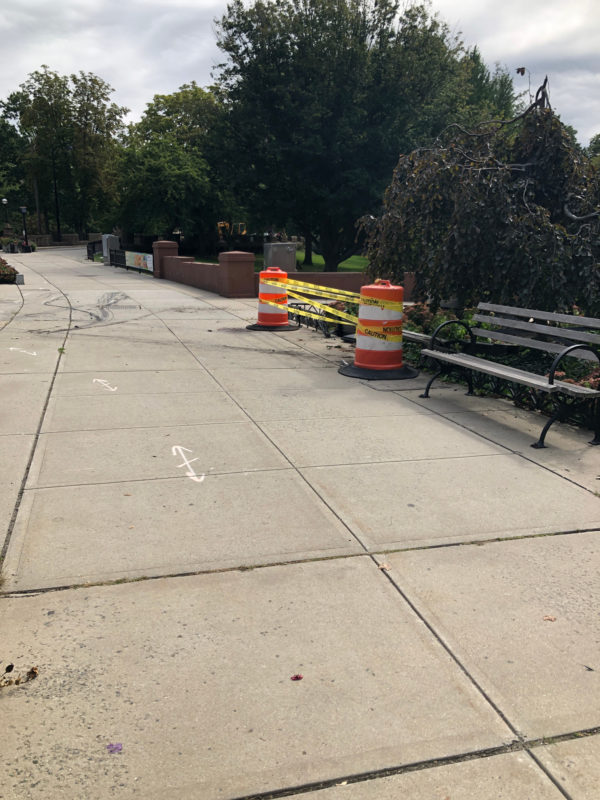
WHAT NEXT
This Sunday!
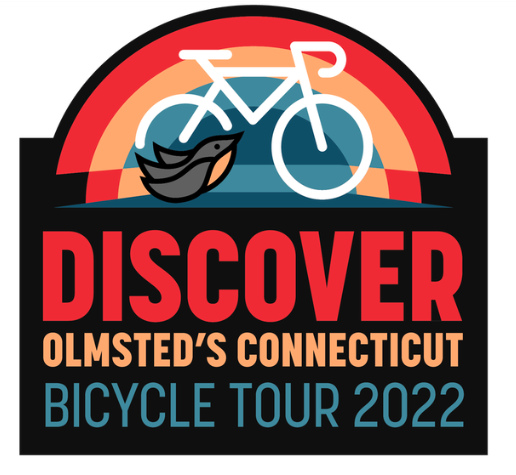
Car-Free Diaries: Week 42
Instead of screaming into the void of Twitter, I bring you a weekly highlight reel of what it’s like going places in Greater Hartford when one is gloriously car-free. These posts are on a slight time delay because nobody needs to know exactly where I am when I am there.
This was not the first time I’d biked to the Wethersfield/Newington/Hartford line, but it was the first time I let Google Maps tell me which route to take, and that was dumb. I knew it before I even left the house.
I understand why it sent me on the Frog Hollow Expressway, or what outsiders refer to as Fairfield Avenue via Park Terrace, the stub of Summit Street, and then Zion Street. It’s probably not Google’s fault for not knowing any better. It picked streets where there is paint indicating a bike lane or sh(itty)arrows, but say it with me: paint alone is not protection.
My bicycle is not a lightweight racing bike. She’s thick. Even more now that she has multiple battery packs and was carrying a camera, lock, and full water bottle. Not a plastic water bottle. Why would I opt for that when I can choose something even heavier?
First minute of ride: correct direction down half of a one-way street, expertly dodging pot holes because I know where each one is. Able to make a left turn onto a stupidly fast street because there was a creepy lull in traffic. This is going to be great! Smooth sailing! Nobody has honked at me in the 2.5 blocks I’ve traveled.
And then?
And then a lane disappeared by Pope Park, where there is no sidewalk, so I had my first “rear end a parked car or take the lane and piss everyone off” moment. Looking at Summit Street, I realize I need to get on the sidewalk because it’s too much hill combined with too much road chaos. That’s fine. I can get off and push for one minute. It’s not like I’m some dude who has something to prove.
Except toward the top, some clueless person is doing this thing that I can’t understand. One person is standing outside a car, another person is in the car, just chilling, with door blocking most of the sidewalk. Person in vehicle is resting foot on the opened door. The person on the sidewalk sees me approaching. I am visible, or rather, if nothing else, my bike is visible. I assume they’ll close door and let me through. Ha, ha. Nope. There’s also a row of recycling or trash cans on other side, making the space tighter. So, I push my bike through, scratching my hand on the bins while dragging the bike against the car. They just stared. This was all in the first three minutes of my trip.
Next up: turning onto Zion Street, where there are faux bike lanes. There is paint, but nothing to prevent people from driving vehicles into the space. I’m about one minute on this road, thinking that perhaps those sidewalk blocker dudes aren’t going to come after me, when I get punish passed by a genius in a shitbox who had to wait five seconds for me to roll by before he could turn from a side street onto Zion. And by punish passed, I mean he swerved right into the lane next to me and I had to ride into the parking area to avoid him. Then, I have some dodging to do of construction equipment beached in the bike lane, along with an SUV that someone parked at an angle in the lane because they’re too incompetent to parallel park and someone’s bodega run is always an emergency.
I still had a ways to go before reaching my destination: Cedar Hill Cemetery. Why the cemetery? It’s there. And because that way, if some asshole splattered me on the road, my friends could all say shit like “Well, she did say she was trying to visit the graveyard.”
Here’s the other problem with the bogus Zion Street “bike lane”: it ends when you need it most — going up a hill by the intersection of New Britain Avenue and Fairfield Avenue. You know, the one where people die because instead of reducing travel lanes, the City would rather put out a large sign asking people to slow down.
I sweat my ass off to make it across the way, and then ride on the joke sidewalk that’s broken and just stops in the park, because I guess nobody thought having sidewalks along the edges of all city parks would be useful. I off-roaded for a bit, hoping to not suffer the consequences as Hyland Park along Fairfield Avenue is basically one long path of broken beer bottles.
Not sure when the exact moment was, but I decided to get back on the street where there are sh(itty)arrows (“full of sound and fury, signifying nothing”) and fast cars. Fairfield Avenue at least has a little more space for avoiding the parked cars. There are driveways. Why is on-street parking even allowed here? Why is it allowed anywhere?
When this got old, I moved onto the sidewalk. As we know, sidewalks don’t protect either (see: dumb shits having car parties with open doors) and this means needing to watch every single driveway and then do super awkward street crossing.
So, I make it to the cemetery, of my own accord.
You may think this would mean stress-free cycling. You’d be wrong.
There is a special ring of hell for people who decide to go bombing around in graveyards. They’re probably related to the folks who must get their Doritos and Red Bull, stat. What’s the emergency? Do you think Great Great Aunt Doris can’t wait another ten seconds for you to arrive with her annual Mums? Calm down. She’ll still be there even if it takes you another hour — trust me.
It got much better when I put myself in areas where people were not allowed to wear their cars.
Deer, hawks, vultures, dragonflies, lots of mud. That’s what I came for.
When it was time to return home — as dictated by my growling stomach and desire to not remain here forever — I did have to think through the route in advance, so that I did not turn without thinking and wind up back on Zion Street.
Because being less aggravated is more important than worrying if I lose cred, I did sidewalk riding on Fairfield until just before the New Britain Avenue intersection, then got back in the street to take Summit along the Trinity College campus. This turned out to be a good decision because Summit Street is now significantly less of a hellscape. There are no bike lanes, but recent changes to the road makes it feel manageable in ways that Zion Street, with “bike lanes,” simply does not.
What changed? There are several speed humps, and at the intersection with College Terrace, a flashing red light has been added at the stop sign.
From there, I rode through Zion Hill Cemetery — no cars to dodge, partly because there are no overly wide roads — and then back on the streets where there were no painted bike lanes or sh(itty)arrows, yet less chaos for whatever reason.
The graphic above (props: US DOT Federal Highway Administration) has been getting some circulation on social media lately, and I think it’s both useful and trash, because we can have a lot of conflicting feelings at once.
I’m stuck on the word “confident.” Also, “comfortable.”
By behavior, I would probably be on the far right part of this infographic.
By emotion, I would be home on the couch.
Confident in what way?
Confident that riding on the road means I’m gonna die and the driver won’t even lose their license after killing me?
Okay then.
I am not comfortable with fake ass bike lanes or with riding in traffic, but depending on where I am, the alternatives, and my mood, I will do those things. And again, because I am not some bike bro obsessed with my cred and looking tough, I will ride on the sidewalk if that’s significantly better than the street.
This infographic would perhaps be more accurate if it measured things like how exasperated a cyclist was with how the roads (that cyclists were responsible for creating) were ripped out from them, and the amount of begging it takes to get slivers of it back. Maybe a “resentful and anxious, but riding on the road anyway” category. How about showing riding behavior without linking it to feelings?
It does illustrate something important though: most cyclists are not willing to cycle on all roads regardless of conditions. This informs, or should inform, design such that it caters to the majority of riders.
For too long, the most vocal cyclists have tended to be those representing a very narrow demographic, and now that others are out there and speaking up, there’s the predictable eye-rolling backlash. And I’m here to make it very uncomfortable for those would-be gatekeepers who make ableist comments.
HARD OUT HERE FOR A BOLLARD
The few bollards in downtown Hartford are not looking so well.
The wooden ones defending a sidewalk against a surface lot appear to have been set on fire. Have they always been like this and I never noticed? Is this new? I’d ask who is lighting bollards on fire, but it’s probably the same person who ignites portapotties.
Not surprising in the least, a bollard by Bushnell Park has gotten abused.
When, instead of narrowing streets around a park so that people drive slower, you remove medians. . . don’t be surprised when automobilists ditch their vehicles in the landscaping and beside benches.
Maybe that’s not exactly what happened, but the marks are there.
At what point are the downtown dwellers and Friends of Bushnell Park going to get involved in dealing with this unpleasantness? Between the speeding around the park and the driving in it, you have to wonder about people’s priorities.
The last two summers have been increasingly obnoxious, with more and more people driving through the park during events. It’s not legal. There’s no reason for it. More than once, I’ve watched as drivers come out of the park, competing with pedestrians entering it during the pedestrian light phase by Union Station. Why does it feel like asking for so much to have one car-free space in a neighborhood, where people of all ages can relax without having to be vigilant about someone driving through who might “confuse” the gas with the brake?
WHAT NEXT
This Sunday!
Related Posts
Place This Place
Connecticut Trails Day: Keney Park
Meet Your City: Small Parks